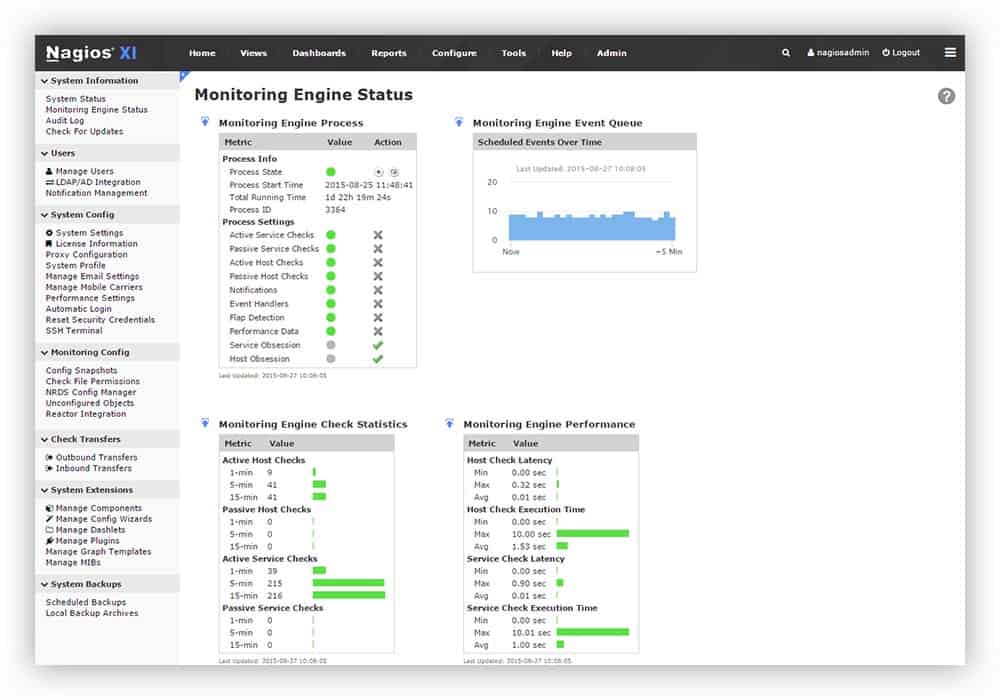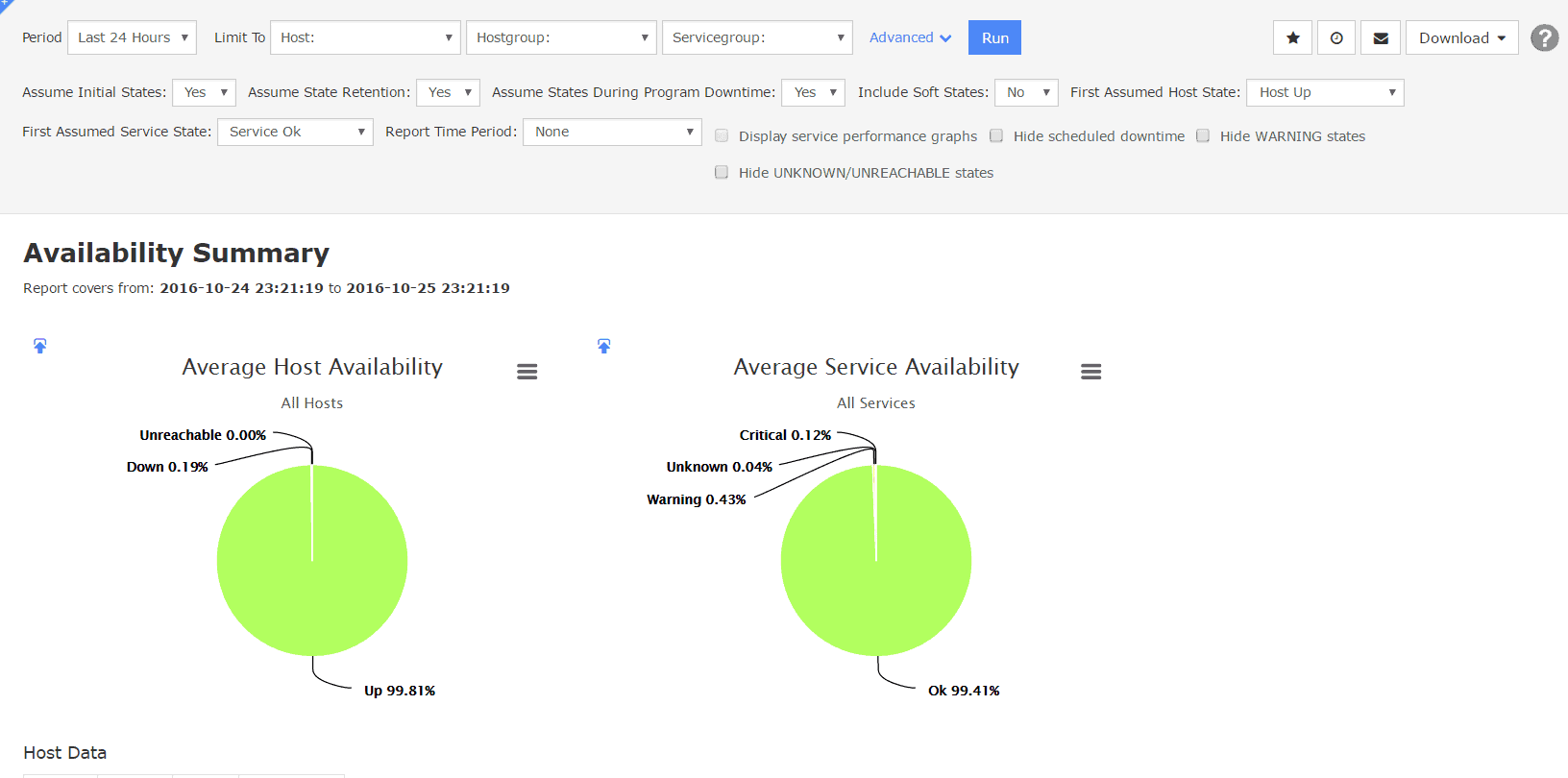Nagios XI is a network monitoring, reporting, and alerting software for network / systems administrators. This article will briefly cover the pricing, main features, system requirements, and official links for the software.
Why do we recommend it?
Nagios XI offers a highly customizable web interface and diverse monitoring capabilities, allowing it to adapt to various network environments. With detailed reporting and notification features, it serves as a comprehensive tool for both real-time monitoring and historical data analysis.
Who is it recommended for?
Nagios XI is suitable for businesses of all sizes that require flexible and customizable monitoring solutions. It’s especially good for organizations that need detailed reporting, alerting functionalities, and LDAP support for departmental use.
Pricing
Nagios XI has two distinct editions with three options each when it comes to pricing and licensing. They are as such:
- Standard Edition:
100 Node – $1,995
200 Node – $3,495
300 Node – $4,995
400 Node – $5,995
500 Node – $6,995
1,000 Node – $11,995
Unlimited Node – $19,995
Standard edition includes GUI configuration, reporting, visualizations, custom dashboards / views, notifications and more. - Enterprise Edition:
Enterprise Edition Upgrade cost $1500 on top of the cost of the Standard Edition version you have (see above for the Nodes and pricing) . Enterprise edition includes all the above listed features, as well as Bulk tools, Audit logging, SLA Support & Reports, Automated host decommissioning, Capacity Planning Reports, Server Console Access, Scheduled Pages, SNMP Trap Interface and tons of other options!
Please note that the Enterprise edition requires an annual renewal of the Maintenance and Support or Maintenance Only contract.
The renewal fees are listed below for 2019 (recently updated with New Pricing Figures):
- Standard Renewal (Maintenance and Support):
This option costs $1,695 for 100 Nodes, $2,795 for 200 Nodes, $3,995 for 300 Nodes, $4,795 for 400 nodes, $5,595 for 500 Nodes, $9,595 for 1,000 Nodes, and $15,995 for Unlimited Nodes. - Standard Renewal (Maintenance Only):
This option costs $645 for 100 nodes, $1045 for 200 nodes, $1,495 for 300 Nodes, $1,795 for 400 Nodes, $2,095 for 500 Nodes, $3,595 for 1,000 Nodes and $5,995 for Unlimited Node+ plan. - Enterprise Renewal (Maintenance and Support):
$750 plus the Renewal of the Standard Edition Node Count from Above. Example, if you have 100 Nodes, the renewal is $1695 + $750 (for Enterprise Upgrade). - Enterprise Renewal (Maintenance Only):
$750 plus the Renewal of the Standard Ed. Node Count from the Standard Maintenance Only section above. Eg: 100 Nodes, the renewal is $645 + $750 (for Enterprise Upgrade). - If you would like to add phone support, you can purchase either 5 calls for $1995, or 10 calls for $2995. These expire when the license expires.
Features
Lets Review the Main features of Nagios:
- Customizable Web Interface:
Nagios XI includes a dashboard viewed in a web browser, which can be used to monitor and manage network devices. Nagios options and settings can also be configured from the web browser, and the dashboards can be customized to display an overview for easy status updates. - Diverse Monitoring Capabilities:
Nagios XI is capable of performing active / passive host checks, service checks, collecting various types of system information, monitoring applications, network protocols, and more. Third party addons are available, further increasing the monitorable scope of Nagios XI - Reporting Services:
Nagios XI supports custom reports detailing all sorts of events based on user-defined filters. Some of the filtering options include time ranges, hosts, groups, and more. The data is displayed in both pie chart and table format, and these can be added to the dashboard or exported to a JPEG if necessary, with two clicks. - Notification Features:
Nagios XI can send alerts using either Email or SMS. Filtering options are available for only allowing certain types of alerts. The options of statuses listed are acknowledgment, recovery, down, unreachable, flapping, or downtime for hosts. The same options are available for Service, with the addition of warning and critical statuses, and the removal of unreachable status. Notification’s messages themselves can be further customized, and sending test notifications is supported as well. - LDAP Support and Custom Users:
Nagios XI is capable of integrating with LDAP and defining different access levels and views for different users, allowing for departmental use instead of just one admin account. - Bandwidth Monitoring via SNMP:
Nagios provides in-depth analysis of your Network Bandwidth by Monitoring via SNMP v1, 2c, or 3. Get a look into your network interface utilization and the amount of traffic inbound and outbound network interfaces. Easily pinpoint Over trafficked or utilized ports, discover network traffic/bandwidth hogs in your network and quickly identify latency or outages.
OS Compatibility / System Requirements
Nagios XI supports the following minimum requirements:
- At least 20 GB of free hard drive space.
- 2 GB Memory or more.
- Dual Core 2.4 GHz CPU or faster.
- CentOS or RHEL (Red Hat Enterprise Linux) versions 5, 6, or 7.
- MySQL, plus PostgresQL if running versions less than Nagios XI 5 or upgrading from pre-5 version.
There are additional hardware minimums depending on monitored nodes / services.
- 50 hosts, 250 services:
At least 40 GB disk space, 1-2 cores, and 1-4 GB RAM. - 100 hosts, 500 services:
At least 80 GB disk space, 2-4 cores, and 4-8 GB RAM. - More than 500 hosts, more than 2,500 services:
At least 120 GB disk space, more than 4 cores, and more than 8 GB RAM.
If monitoring over 1000 hosts or 5000 services, a dedicated physical server is recommended.
Please note that the download is available for VMware, VirtualPC, and Source Install, meaning that the only servers that can run the software natively are CentOS and REHL as listed above, unless using a virtual machine.
If you are running windows, you can still use a virtual machine using either the VirtualPC or VMware images available for download. While the server software does not run on native Windows, you can still monitor all windows servers, workstations, and other network devices.
The VMWare image will require an ESX Server, VMWare Workstation, Player or VirtualBox in order to run the virtual machine. The image is running CentOS 6, and networking is set to bridge mode with DHCP enabled. Initial credentials for the machine are listed on the main site, and should be changed as soon as possible.
Screenshots



Official Links
The Nagios XI main site and overview can be found at:
https://www.nagios.com/products/nagios-xi/
To download the product, please visit:
https://www.nagios.com/downloads/nagios-xi/
Note that the product is available for VMWare 64 bit & 32 bit, VirtualPC 64 bit & 32 bit, and as Source Install.
Nagios XI is a powerful / expandable network monitoring, reporting, and alerting software capable of keeping track of various types of nodes and applications / services on your network. We hope this Nagios Review covered all the basics of the software, including price, system requirements and feature set – If nagios doesn’t fit your Needs, then check out some other nagios alternatives for more options!


